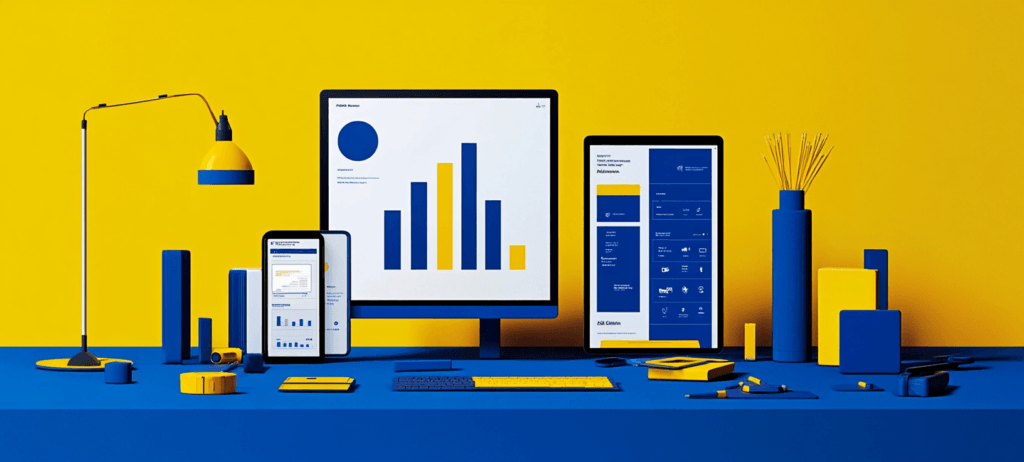-
 Published: Oct 9, 2025
Published: Oct 9, 2025
-
 14 min. read
14 min. read
-
Summarize in ChatGPT
-
 Lornah Ngugi
Lornah Ngugi Marketing Writer
Marketing Writer
- Lornah Ngugi is a seasoned digital marketing writer with 6+ years of experience translating complex marketing strategies into engaging, results-driven content. She holds a B.S. in Business Information Technology and is certified in HubSpot Academy, Google Analytics, LinkedIn Marketing, and Google Digital Academy. Lornah regularly contributes to the WebFX blog and SEO.com, where she’s authored hundreds of marketing guides that help readers turn their goals into measurable results through practical, data-informed insights. When she’s not writing, you’ll find her enjoying a quiet walk in the park, sipping black coffee, or finding creative inspiration in a good chocolate bar.
Table of Contents
- 11 top-tier examples of SEO tactics in action
- 1. Long-tail keyword integration
- 2. White space
- 3. Compelling title tag and meta description
- 4. Reputable backlinks
- 5. Fast page speeds
- 6. Responsive design
- 7. User-friendly navigation
- 8. E-E-A-T optimization
- 9. Position-zero results
- 10. Local SEO
- 11. User-generated content
Search engine optimization (SEO) is the perfect avenue for getting your website to appear prominently in Google searches. All you have to do is optimize your website and content to satisfy Google’s ranking algorithms, and you’ll soon have a shot at appearing near the top of search results.
The trick, though, is figuring out exactly what it looks like to satisfy those algorithms.
Even if you read up on some SEO tactics you can use, it’s still hard to know what they look like in practice. That’s why we’ve drawn up top SEO examples to help you determine what to prioritize when optimizing your website for SEO.
11 top-tier examples of SEO tactics in action
While browsing SEO content sites, you may have read about things like keyword integration or mobile-friendliness before. But without context, those phrases may not have given you a clear direction for your SEO optimization efforts.
To that end, here are eight of the best SEO examples to show you what various tactics look like in practice and inspire your own online marketing:
11 top-tier examples of SEO tactics in action
Find out more about each one below.
1. Long-tail keyword integration
Incorporating keywords into your written web content communicates to Google which searches your content is most relevant to, helping it rank for them.
In 2025, you should aim for long-tail keywords, which are typically 3+ words. These longer keywords tend to be more detailed, high-quality, and with lower competition, meaning you can reach a more relevant audience while avoiding high competition from other businesses in your industry.
Aireserv is a great example of a company that effectively used long-tail keywords in its content.
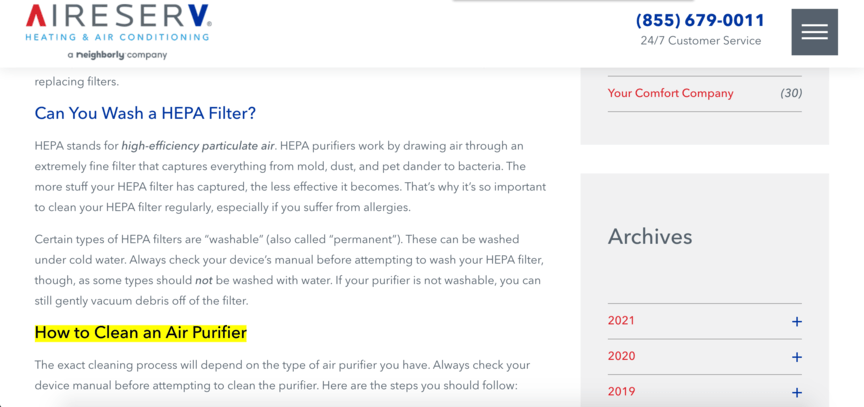
In one of their blog posts on cleaning air purifiers, they didn’t simply target a short keyword like “air filter” — they went after the long-tail keyword “how to clean an air purifier,” which they included in both the title and subheading of the piece.
As a result, their article holds the top spot in Google rankings for that keyword!
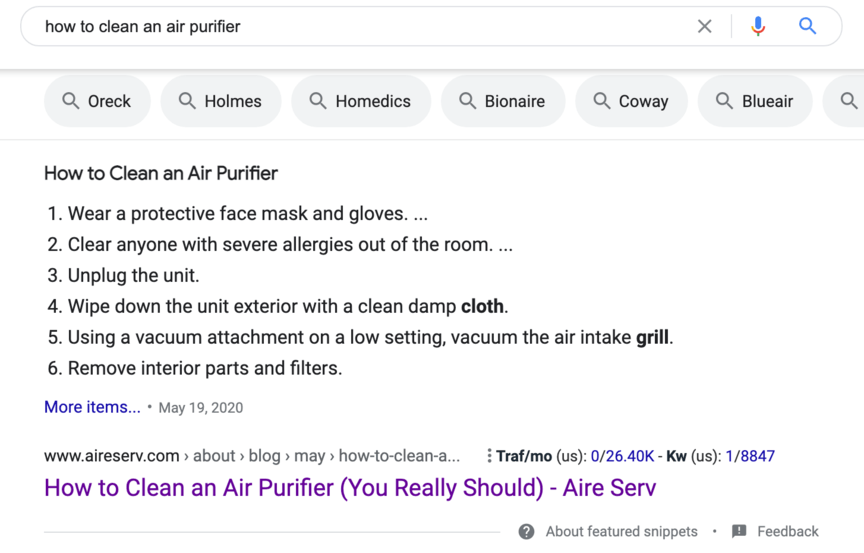
2. White space
Visual design is one of the primary contributors to the overall user experience on your website. If your site has a poor appearance, users won’t want to stay on it. And when users keep clicking away, that tells Google to rank you lower.
Visual design is composed of various elements, with everything from color schemes to page structure. But one of the main visual elements that determines user experience on a site is white space.
White space is simply the space on a page that isn’t taken up by text, images, or other visual elements. Imagine having the option between a page completely packed with text and a page broken up into small blurbs and paragraphs.
Which would you rather read? Probably the latter.
Sun Auto Service demonstrates this principle seamlessly in its written web content.
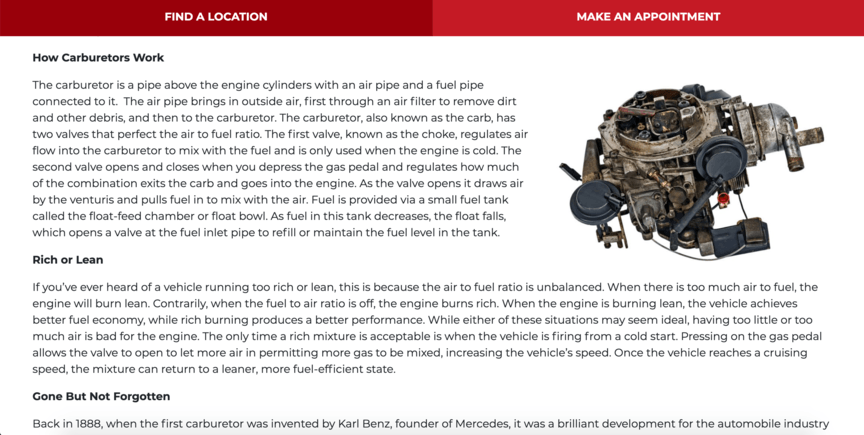
In their informational pieces, they make sure to break up text into small sections. With headings, images, and white space inserted between the paragraphs, it makes things feel far less cluttered, leading to easier reading and happier users.
So, you need to be keen to space your page contents appropriately to ensure a positive user experience that drives more traffic and conversions for your business.
3. Compelling title tag and meta description
SEO starts with getting your content ranking in Google, but it doesn’t stop there. Once your content is ranking, you have to convince users that your site is the result they should click. If you don’t, you won’t stay high in rankings for long, since Google will assume your site isn’t valuable or relevant to users.
To gain clicks, you need to add a compelling title tag and meta description to each of your pages. Why? Together, this is the blurb that appears in search results and convinces clients to click through to your page. The title and meta should make it clear what your business is offering and why users should click.
The Exterminator in Wyoming does a fantastic job with this tactic.

Their title tag makes it clear what they do and where they operate. Their meta description, meanwhile, provides a compelling call to action (CTA) and highlights their “years of experience.”
4. Reputable backlinks
When Google ranks your site, one of the things it considers is how reputable you are. If Google views your site as authoritative in your industry, it will rank you higher.
But how do you convince Google your site is reputable? Find ways to earn high-quality backlinks. When Google sees a known authoritative site linking to you, it considers that a vote of confidence in your website and considers it to rank you higher.
To earn backlinks, you can start by looking for broken links on reputable sites in your industry and recommend that the site replace them with new links to your content.
Sweetwater offers one of the most impressive examples of SEO in this regard. A short piece on their website entitled “True Stereo” earned a backlink from Wikipedia, which lists it as a reference on its “Stereophonic Sound” page.
While Wikipedia links are NoFollow, meaning they don’t directly impact rankings like most backlinks, the fact that Google consistently ranks Wikipedia so high in search results still benefits Sweetwater significantly, since visitors to that page may encounter the link.
It’s no coincidence that the same Sweetwater piece ranks on page one for the keyword “true stereo!”
5. Fast page speeds
Did you know that 83% of users expect pages to load in three seconds or less? If your site doesn’t meet this expectation, you’ll have quite a number of users bouncing from your site, which will tell Google that your site isn’t useful to them, causing it to rank lower.
That means you need page speed optimization. Even a 0.1-second improvement in page speed can increase conversion rates by as much as 8%, so it’s definitely a worthwhile tactic.
To improve your page speeds, you can implement techniques like:
- Compressing images
- Caching web pages
- Limiting redirects
You can check your website’s page speeds on Google’s PageSpeed Insights tool, which will give it a score between zero and 100. For an example of a site that’s managed to achieve an impressively high score, we can look at USA Flooring.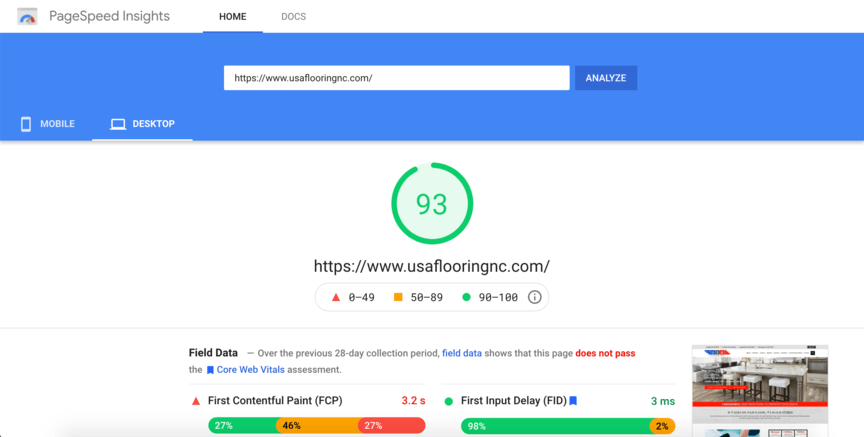
USA Flooring’s desktop site earns a 93 in PageSpeed Insights, meaning they probably don’t see many users jump ship during the loading process.
6. Responsive design
With over 50% of all Internet traffic coming from mobile devices, it’s no surprise that Google’s algorithms prioritize mobile-friendly websites. In fact, Google now uses mobile-first indexing for 100% of websites, which means they prioritize the mobile version of your website for indexing and ranking.
That means without mobile-friendliness, not only will mobile users not stay on your site, but Google will penalize you in rankings.
To stay high in rankings, you should adopt a responsive design on your site. Responsive design refers to a type of web design where your site changes its layout to fit whatever screen it appears on. One of the best SEO examples of responsive design comes from Ravensburger.
On a computer screen, Ravensburger’s online store displays its products in a grid formation, with three products per row. A phone screen is vertically oriented, however, so the store’s mobile version lists the products in a single column running down the page.
Here’s their site on desktop:
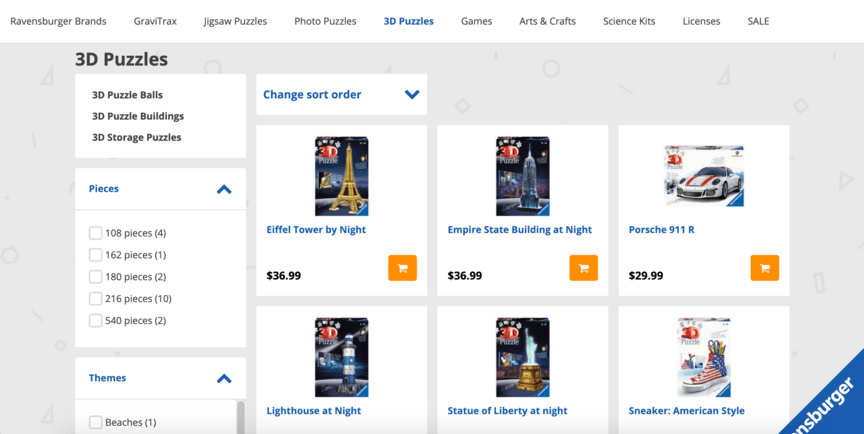
And here it is on mobile:
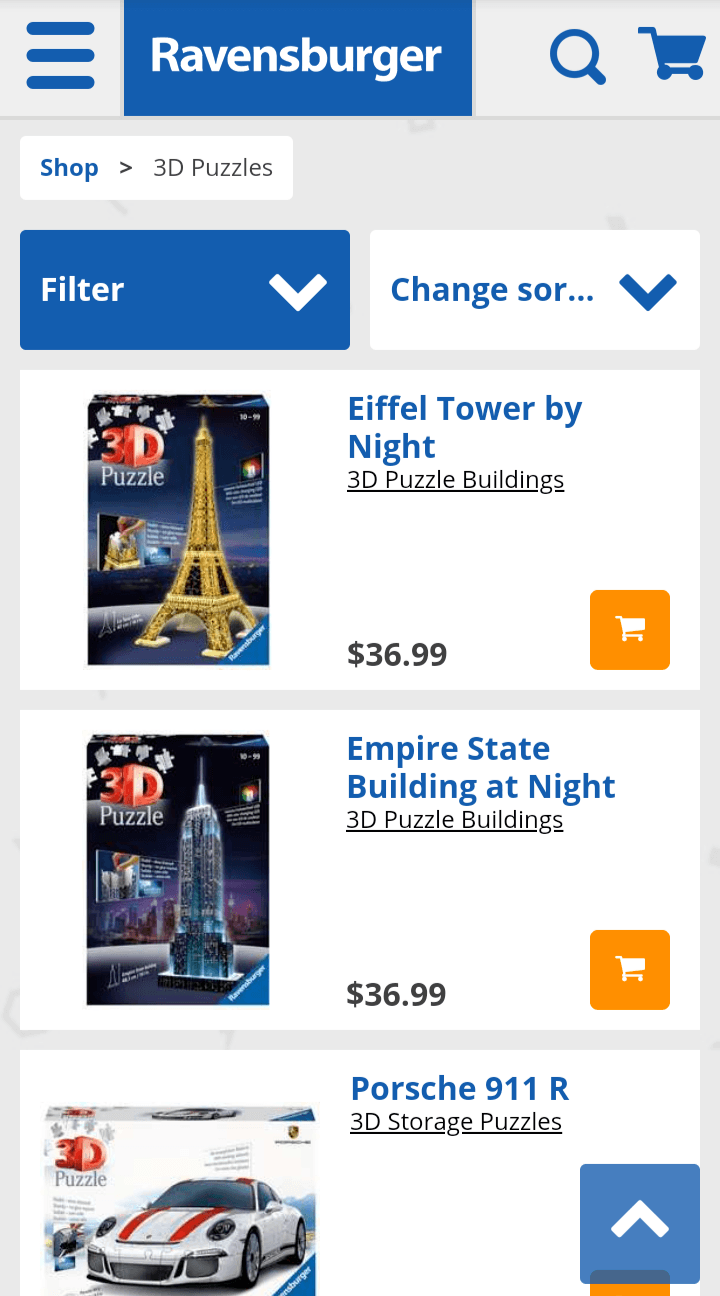
7. User-friendly navigation
One of the most essential aspects of good web design is navigation. When someone visits your site, they need to be able to easily find what they’re looking for. That means your site layout needs to be clear and organized.
The simplest way to do this is to use a navigation bar at the top of your website, which is exactly what Samsung does so well on its website.
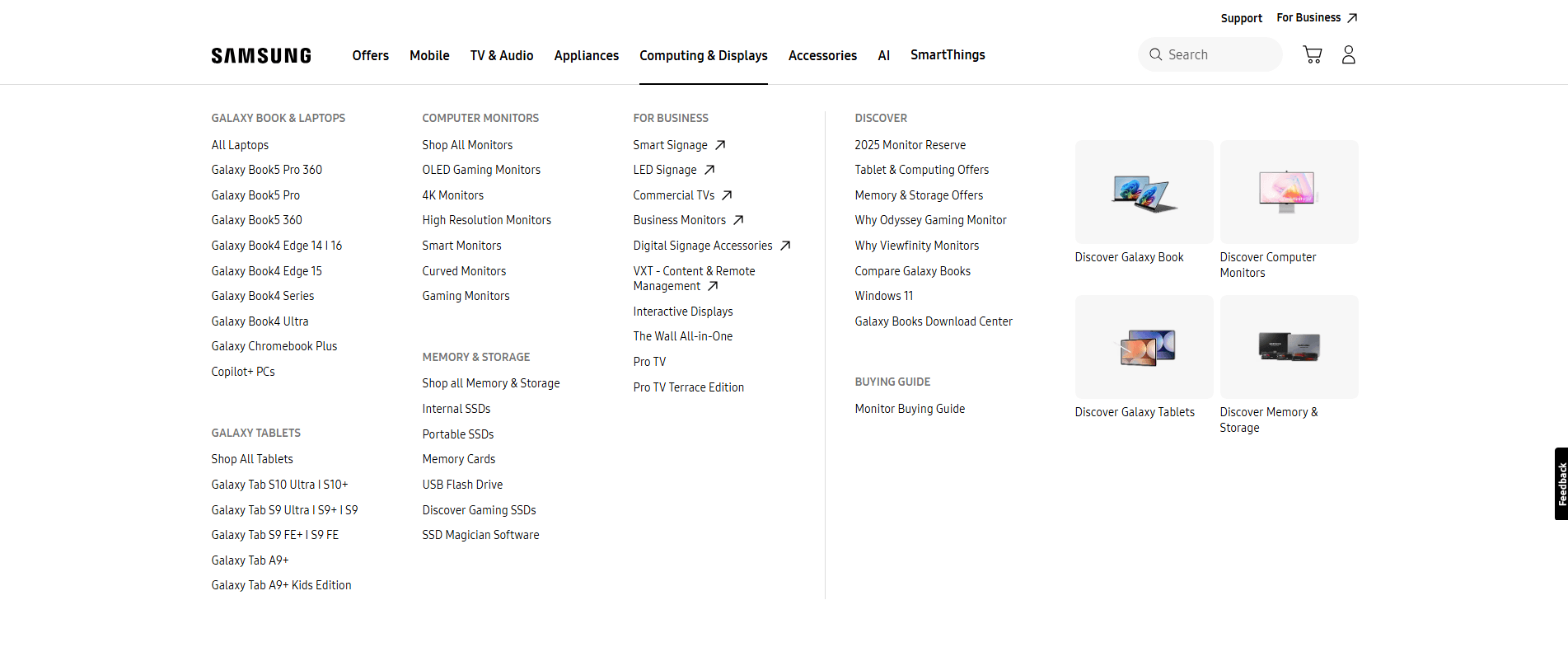
As you can see, the major sections of the website are clearly laid out in the navigation bar. You can quickly jump to whichever product category you’re interested in. Plus, Samsung goes a step further — if you hover over any of those tabs, you get a dropdown box that displays all of the additional sections within that larger category.
That means users can find what they’re looking for in a matter of seconds. Your own site should be equally simple to navigate, with content divided into clear categories.
8. E-E-A-T optimization
In recent years, Google has put an increased emphasis on E-E-A-T as an indirect ranking factor. E-E-A-T stands for Experience, Expertise, Authority, and Trust.
The idea is that if a website can demonstrate a high degree of reputability in its field, users will trust it more. That means the more experience, expertise, and authority you can demonstrate on your site, the higher Google will rank you, and users will trust you.
IIS Financial Services puts this into action on its own site in a major way. Right from their homepage, they include multiple buttons and links to their “About Us” page, which outlines the long history of financial experience they have.
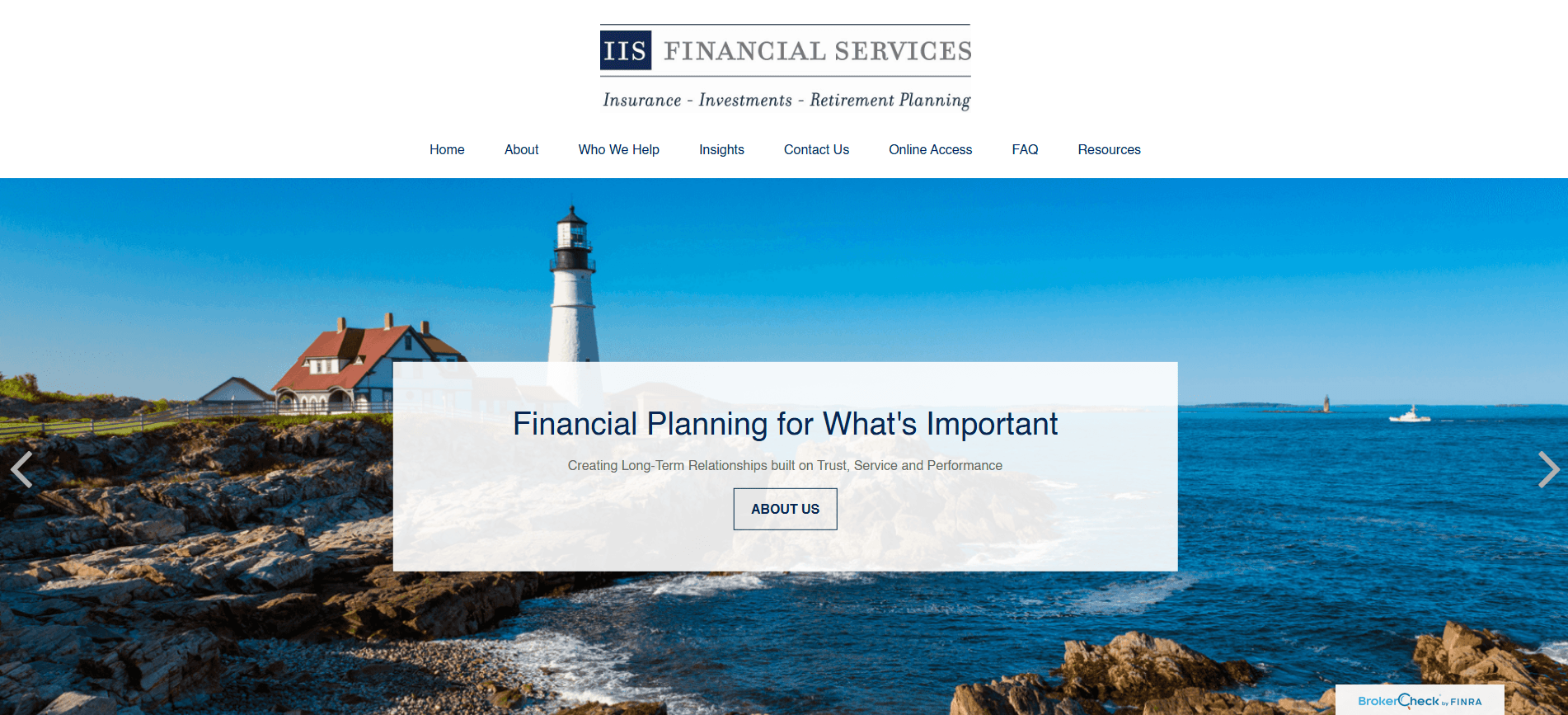
Additionally, IIS has a blog where they regularly post about financial topics to demonstrate their expertise. And to cap it all off, they feature a variety of case studies on their site showing exactly how they drove results for their past clients. That leaves no room for doubt that they’re an authority in financial consulting.
Whatever your industry, you should aim to demonstrate this same level of authority on your own website to boost your rankings.
9. Position-zero results
Position zero is the most coveted position in search results because it appears above the standard organic and sponsored listings, giving you more visibility, increased organic traffic, and clicks. For the last decade, featured snippets were the most popular type of position zero results, but they’re now being quickly overtaken by zero-click searches.
AI overviews, knowledge boxes, and direct answer boxes are the more popular examples of zero-click searches. These searches end without users clicking on any links, so they don’t drive direct traffic and clicks, but boost search visibility and create brand awareness.
To appear in zero-click searches, you need to optimize for featured snippets by answering user searches and implementing schema markups on your website.
Mayo Clinic is an example of a business that has effectively optimized for zero-click searches, seeing that for some queries like “appendicitis symptoms,” they’ve scored triple wins. As you can see in the screenshot below, they appear in the AI overview, first source, and position one.

10. Local SEO
Whether you run a localized business like a healthcare facility or an e-commerce store without geographical limits, you need to optimize for location-specific searches. This will mean customers are conveniently positioned and ready to purchase, and clients can easily find your brand, products, and services.
You can’t afford to ignore SEO, especially not when 80% of local searches lead to conversions and 49% of consumers admit they would buy from a business with a local presence. Optimizing for local SEO involves several steps that aggregate to higher rankings on localized business searches. These include:
- Claiming your Google Business Profile (GBP) listing
- Strategically inserting locally-targeted keywords throughout the website
- Earning citations and mentions from complimentary local businesses
- Earning and efficiently responding to reviews on Google and third-party review sites
Asbury Electric is an example of a company that has effectively optimized its site for local SEO. As a result, they now appear in search results pages for electricians in Gloucester Point, Virginia. They position themselves as “your local residential electrician” and appear in the local-3 pack, which is the most prominent position for the most relevant businesses.
They’ve effectively positioned themselves as a franchise, which means they also rank highly for local search in other areas, including Charles City, Matthews, New City, and Norfolk.
11. User-generated content
In 2025, customers trust recommendations from influencers more than they trust brands themselves. In actuality, three in every ten millennials say they value influencer recommendations more than traditional ads. Additionally, five in ten millennials admit they find influencer marketing more engaging than traditional marketing ads.
So, this means you need to leverage influencer marketing as part of your SEO strategy. Additionally, other than influencers, you should also bank on your community by reposting their user-generated content (UGC). UGC is relevant to SEO because it counts towards reviews, which 88% of consumers say they trust online reviews from other consumers as much as they trust recommendations from their friends and family.
Companies like SET Active have discovered the secret behind user-generated content campaigns. In 2024, SET, the activewear brand, launched the SET Surprise UGC campaign. It involved them selling mystery boxes to their customers, many of whom couldn’t resist unboxing them and tagging them on TikTok and Instagram.

The campaign generated thousands of videos and millions of views, likes, and comments, meaning they significantly boosted their brand awareness, sales, and client base.

If you’re inspired to launch your own UGC campaign, be inspired by this list of 14 inspiring user-generated content campaigns.
Let WebFX optimize your marketing with superior SEO tactics
At WebFX, we understand the complexities that come with managing SEO — that’s why we’re here to help you optimize your online marketing with various SEO packages! With over 29 years of experience, our SEO web design agency knows what it takes to get your site ranking in Google search results.
WebFX is a full-service digital marketing solutions provider with award-winning marketers, designers, and developers. We’re proud to be the best Atlanta SEO agency and an industry leader in SEO across the globe!
With our SEO services, you’ll receive help implementing every one of the tactics listed above and more. You’ll also receive a dedicated account representative to keep you closely informed about everything we do for your campaign. To get started with us, just call 888-601-5359 or contact us online today!
-
 Lornah Ngugi is a seasoned digital marketing writer with 6+ years of experience translating complex marketing strategies into engaging, results-driven content. She holds a B.S. in Business Information Technology and is certified in HubSpot Academy, Google Analytics, LinkedIn Marketing, and Google Digital Academy. Lornah regularly contributes to the WebFX blog and SEO.com, where she’s authored hundreds of marketing guides that help readers turn their goals into measurable results through practical, data-informed insights. When she’s not writing, you’ll find her enjoying a quiet walk in the park, sipping black coffee, or finding creative inspiration in a good chocolate bar.
Lornah Ngugi is a seasoned digital marketing writer with 6+ years of experience translating complex marketing strategies into engaging, results-driven content. She holds a B.S. in Business Information Technology and is certified in HubSpot Academy, Google Analytics, LinkedIn Marketing, and Google Digital Academy. Lornah regularly contributes to the WebFX blog and SEO.com, where she’s authored hundreds of marketing guides that help readers turn their goals into measurable results through practical, data-informed insights. When she’s not writing, you’ll find her enjoying a quiet walk in the park, sipping black coffee, or finding creative inspiration in a good chocolate bar. -

WebFX is a full-service marketing agency with 1,100+ client reviews and a 4.9-star rating on Clutch! Find out how our expert team and revenue-accelerating tech can drive results for you! Learn more
Try our free Marketing Calculator
Craft a tailored online marketing strategy! Utilize our free Internet marketing calculator for a custom plan based on your location, reach, timeframe, and budget.
Plan Your Marketing Budget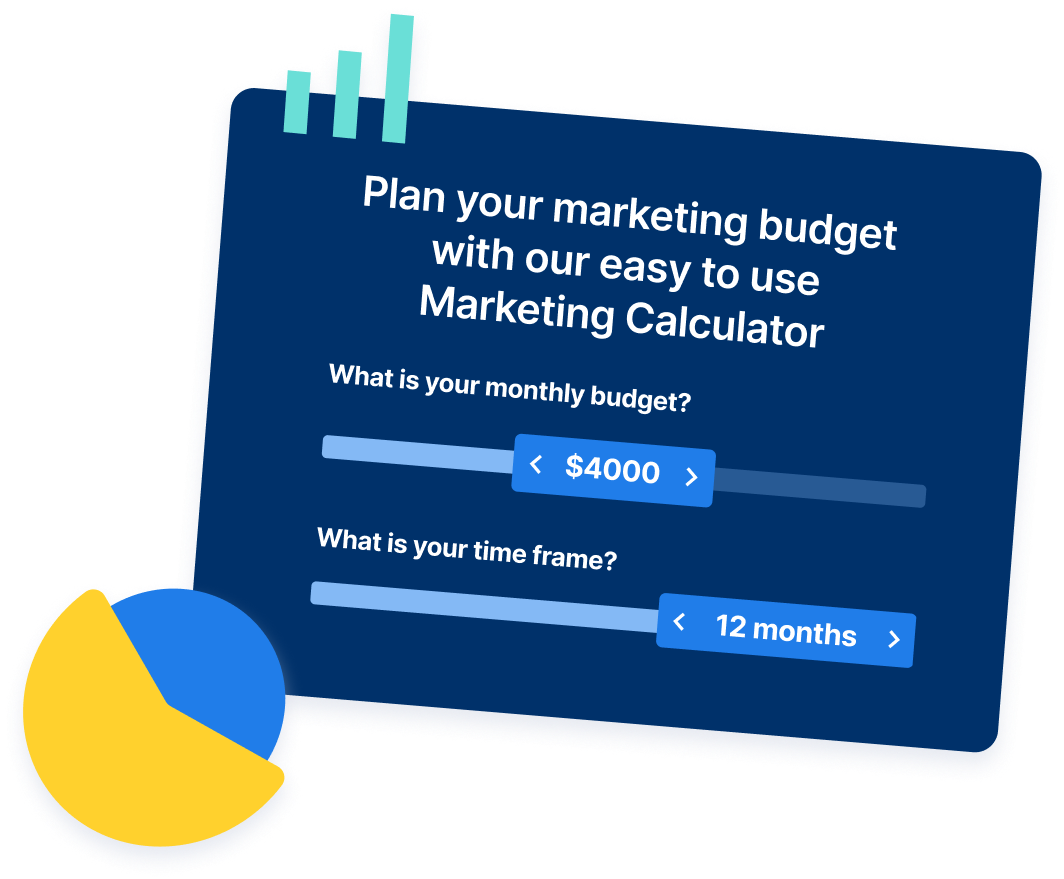
Table of Contents
- 11 top-tier examples of SEO tactics in action
- 1. Long-tail keyword integration
- 2. White space
- 3. Compelling title tag and meta description
- 4. Reputable backlinks
- 5. Fast page speeds
- 6. Responsive design
- 7. User-friendly navigation
- 8. E-E-A-T optimization
- 9. Position-zero results
- 10. Local SEO
- 11. User-generated content

SEO Success with KOA

Proven Marketing Strategies
Try our free Marketing Calculator
Craft a tailored online marketing strategy! Utilize our free Internet marketing calculator for a custom plan based on your location, reach, timeframe, and budget.
Plan Your Marketing Budget



